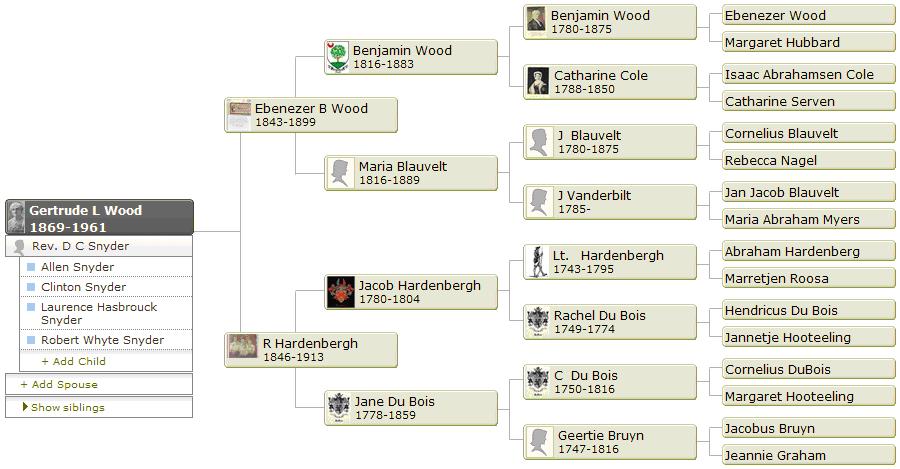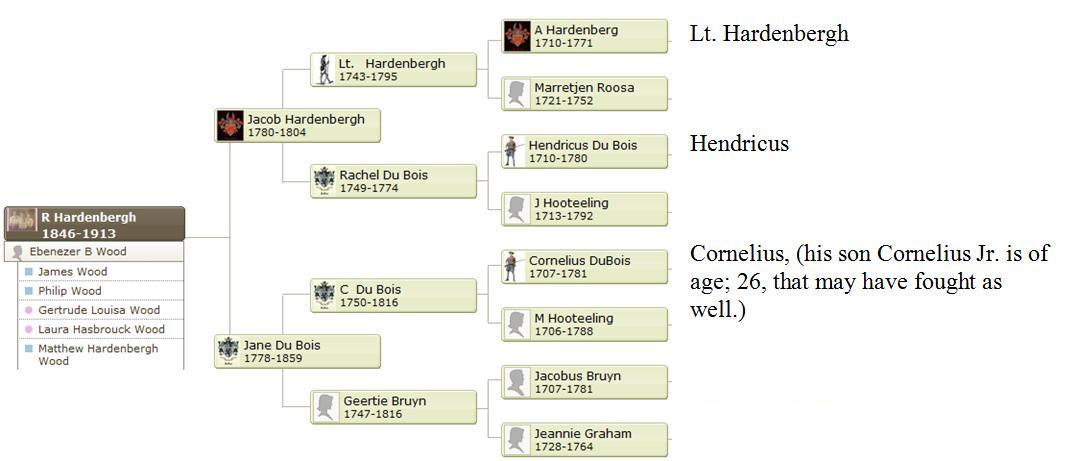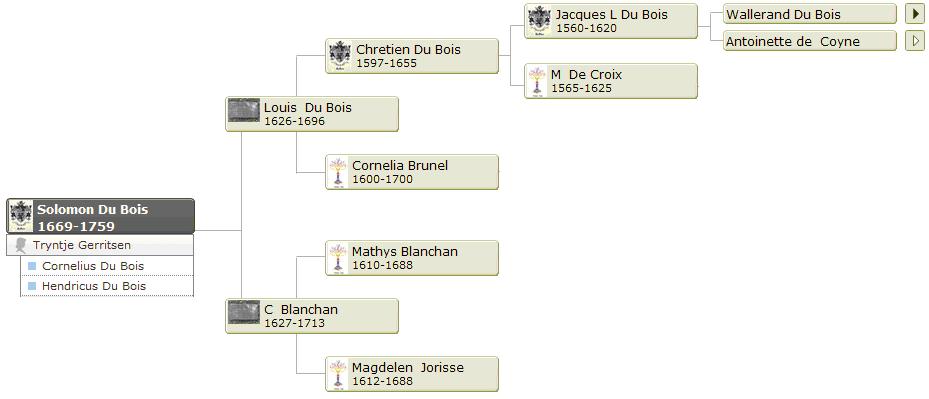THIS INFORMATION IS BASED ON THE PETERSEN/SNYDER LINE:
|
A brief Sketch of the Du Bois Family
Originally the name was spelled with a small ?d? and a capital ?B?, the ?du? being a contraction of ?de la?
Two quite distinctive coats of arms are shown as belonging to the family. One portraying an eagle on a golden shield surrounded by a steel helmet of an esquire. The other shows a lion rampant on a silver shield with the family crest having the lion between tree stumps.
The motto of the family was a staunch one ? ?Hold to thy Faith!? and much was it needed as persecution from their home in the little province of Artoes.
The first member of the family to migrate to America was Louis De Bois who had fled to Mannheim Germany.
There he married Catharine Blanchan, also a refugee. Later from Holland they sailed on the ship ?St. Jan. Bantiste, landing in America Aug. 6 1661.
Louis was a Huguenot or more correctly a Walloon and we find him frequently referred to him in the old records as ?Louis, the Walloon.?
With a hand of Huguenots and Dutch comrades, this young couple settled on the west bank of the Hudson in what is now Ulster Co. N. Y. Some claim that the Walkill River which runs through that section was named for him and he seems soon to become the leader, the advisor and chief of the colony who?s word was law.
He lead a group of twelve men who secured a patent for land from Gov. Andros and in 1677 some 36,000 acres were purchased from the Indians. Louis?s name heads the list of signers who paid for their land in a curious currency. These are some of the items included in the bill of sale:
The first white settlement was called Nieuw Dork and was later called Hurley, but in 1678 twelve families made the little village of New Platz.
Previous to this however occurred one of those frightful Indian attacks. The story is told in many histories how the Indians surprised the women one day when the men were at work in the fields carrying away among their captives Louis?s wife Catharine and her three children Abraham, Isaac, and Jacob.
For three months the seven women and twenty three children were kept prisoners in the Indian strong hold in the Shawangunk Mts. while husbands and fathers search stealthily for them. At last a friendly Indian guided them to the hiding place. As they drew near they heard a clear sweet voice singing. Catharine was voicing her faith and keeping up the courage of the others by singing the 37th psalm, ?Commit thy way into the Lord, trust also in him and he shall bring it to pass.? And he did not fail her. When the men stole upon the Indians and over powered then they found Catharine bound to a tree, fagots at her feet ready for lighting. Spell bound by her sweet song the Indians had delayed to apply the torch.
Catharine lived many years to hear six more children to do their part in the freeing and building of our land. With the building of solid little stone houses went the building of the church and Louis Du Bois was installed the first elder in the Reformed Church of New Platz 1683.
No history, says a noted historian, would be complete without special mention of the Du Bois family."
Louis Du Bois and Catharine BlanchanLouis and Catherine emigrated Aug. 6, 1661 possibly on the "St. Jan Baptiste". Both came from French Huguenot families in the area of northern France that was at the time known as Spanish Netherlands. They lived in the Paltz or Palatinate along the Rhine River before emigrating to New Amsterdam. Land and privilege were confiscated by the ruling Catholic authorities and under King Louis XIV it became government policy to destroy church or public records which would allow a Huguenot to prove any right to inheritance. Louis and Catherine were among the earliest settlers in the Dutch village of Esopus (now Kingston, Ulster Co, NY) along with her parents who had arrived a year earlier (April 1660) on "The Gilded Otter". Louis served on the Duzine which was the governing body consisting of 12 men from the founding families of the New Paltz as it was known. This area came under Dutch and English influence at different times leading to changes in names, custom, etc. The dealings of this community with the local Amerindians of the Iroquois, Mohawk and other groups is quite well documented.  The Huguenot Heritage Webring
|
|
Pedigree charts from Gertrude Wood Snyder to Wallerand Du Bois
3 More Revolutionary ancestors:
Notice that both Hendricus and Cornelius are sons of Soloman Du Bois; both were revolutionary war vets
Soloman was also one of the first Franch settlers to marry outside the Platz Patentee families. He married Tryntje, a Dutch stettler.
|
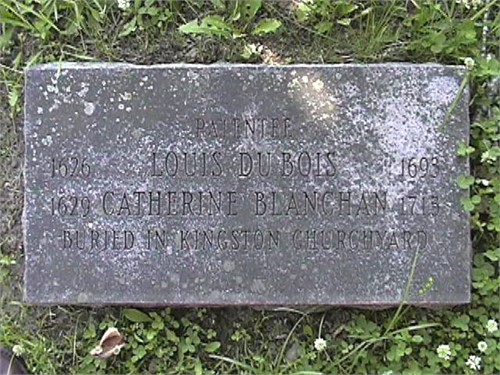
Tombstone Louis Du Bois and Catherine Blanchan
|
|
DuBois Family History
from the DuBois Family Association Website - http://www.dbfa.org
The DuBois family of New Paltz, NY are descendants of Chretien DuBois (b.1597) and his wife Cornelia. He was a
prosperous middle class
linen merchant and devout protestant from the village of Wicres, outside of Lille. In 1659 the area was handed over by the Catholic
Spanish Netherlands to the Catholic regime of Louis XIV, who imposed high taxes on the middle classes and cruelly persecuted the Protestant
(Huguenot) dissidents.
Chretien was the father of five children: Francoise (b.1622), Anne (b.1624), Louis (b.1626-d.1696), Jacques (b.1628-d.1676) and another son,
name unknown.
Resentful of high taxes and fearful of religious persecution, Francoise and Jacques settled in Leyden, Holland. Meanwhile, Louis along
with other Huguenot refugees moved to Mannheim, Germany (near Heidelberg) on the Rhine River. This area was called die Pfalz (hence the
origin later of the village name of New Paltz).
While in Germany, Louis DuBois married another French Huguenot, Catherine Blanchan in 1655. They emigrated to America in 1660 and traveled
ninety miles up the Hudson River to a small community in the Kingston - Hurley area where he obtained a land grant in 1663.
Francoise, and her husband Pierre Billiou also emigrated in 1660, settling in Staten Island, NY. Fourteen years later Jacques and his wife,
Pierrone Bentyn arrived in Kingston.
In the 1660's during the "Esopus Wars", there were many hostile incidents between white settlers and the Esopus Indians. During these times
in 1663 a raid killed 21 people and Catherine Blanchan DuBois and her three children were carried off and held captive for three months before
being rescued by a contingent of Dutch soldiers. During this expedition to rescue his wife tradition has it that Louis DuBois discovered the
beautiful Walkill valley which became his new home.
Jacques children spread across the Hudson River and helped to establish Fishkill and Poughkeepsie. The children of Louis married the offspring
of other patentees of New Paltz which gradually grew into a small self governing village. One daughter, Sarah, married a Van Meter and moved to
New Jersey and then farther south. This branch of DuBoises helped open the way west and contributed to the settling of Kentucky and West Virginia.
The DuBoises, and other Huguenot families of New Paltz, were slave owners. Louis purchased two slaves at public auction in Kingston 1674.
The 1755 census shows Solomon DuBois as owning seven slaves.
The DuBois family takes some small comfort that Catherine DuBois Cottin (Louis DuBois widow) made specific mention in her 1712 will that a
manumission letter written for her slave girl Rachel in 1709 shall "remain in force and be properly observed". (manumission : To free from slavery
or bondage; emancipate.)
Perhaps another counter balance to that history is that W.E.B. DuBois, a founding director of the NAACP and editor of The Crisis from 1910-1934,
dedicates his autobiography to his great grandfather Dr. James DuBois, a physician in Poughkeepsie, who he claims is descended from Jacques in the
fifth generation. DuBois in his nineties, discouraged by the inability of capitalism to bring the highest welfare to its people, believed in communism.
Other famous branches of the family tree: General George Patton, artist Mary Cassatt, actor Marlon Brando and actress Joan Crawford. Louis Du Bois WillLouis died at Kingston, reported by Heidgerd as 23 June 1693. However, Louis had three wills (all written in Dutch) recorded in Ulster County Surrogate's Office, the last of which was dated 22 February 1696, and his wills were proved on 26 March 1696, so his death occurred sometime during that interval of a month's time.13 October 1676 WillAn early will, or more properly defined, a joint agreement of Louis Du Bois and Catherine, his wife, was dated 13 October 1676 and written in Dutch, translated as follows: "After their deaths, the whole estate shall go to their children, the monors first to be educated until they can earn a living. If either should re-marry, he or she shall pay one half to the children, begotten by them, and in case of death, one fourt of the remaining half shall be divided among the children. If the survivor remains unmarried, he or she shall not be compelled to pay out anything more to the children than it may please the survivor, either as a marriage portion, or in some other way. At death of both parties, the children shall inherit the entire estate. In case of re-marriage of either party, without lawful issue, the children shall have one half of the estate."30 March 1686 WillA will dated 30 March 1686, and recorded 5 May 1686, provides that Louis' "estate, after payment of debts to be equally divided 'amongst my children but my two eldest sons desiring to have Each of them a part of the land of New Paltz and more than the other children by Reason their names 'uppon the Patent', but if they will be content 'to deale Equally with my other children whether in land, houses or any other sort of goods whatever belonging to my Estate As well the land of the Paltz....' that if they have the land at New Paltz they should pay a share of its worth to the other children as all of the estate should be divided equally. 'My wife, their mother, shall have the ordering of the Estate as long as she remains a widow.' 'If she marry the Estate to be divided among the children aforesaid except my two eldest sons.'27 March 1694 Will"The second will dated 27 March 1694, proved 26 March 1696, states that if the widow should marry, then to the eldest son Abraham, 6 Pounds, as his primogeniture right, also 1/8 of the estate; son Jacob 1/8; and 1/8 to each of the following children: David, Solomon, Louis, Matthew; and to the children of deceased son Isaac 1/8; and to children of Sara wife of Joost Janse (Van Meter) 1/8. Wife Catherine appointed executrix."Louis' will dated 22 February 1695/6 and written in the Dutch language provides for the disposition of his property as follows: "to my son Jacob half of my farm at Hurley adjoining land of Hyman and Jan Rosa and land of Lammert Huyberse on condition that he pays 1500 shepels wheat; Jacob to use the other half until my youngest son Matthew Du Bois becomes of age, for which he is to pay 50 shepels wheat yearly. I have this day conveyed to my youngest son, Matthew Du Bois, house and land in Kingston, a parcel of me adow land, and one half of my land at Hurley, for which he is to pay 1500 schepels of wheat. Payments for the land which my son David bought from Jan Wood to come out of my estate, as I had promised my son David. My sons Salomon and Louis Du Bois are to have my land in the Paltz, conveyed to me by deed from Coll. Thomas Dongan, dated 2 June 1688, for which they are to pay 800 shepels of wheat. My daughter Sara wife of Joost Janse to have a piece of land in Hurley adjoining the land of Corneles Cool, for which she is to pay 700 shepels of wheat. This includes the woodland adjoining." The Ulster County Genealogy Archive included a brief biography which stated: "There is a memorial to Louis in the Dutch Reformed Churchyard, right across from the Post Office. His actual burial place is unknown, but it is somewhere on the Churchyards grounds." |
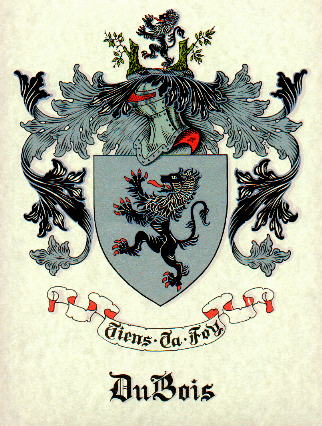 "When William, Duke of Normandy afterward King William the first of England set forth in the year 1066 A.D. on his conquest of England he was accompanied by Geoffroi du Bois a member of one of the oldest families in the noble houses of Cotentin in the duchy of Normandy
"When William, Duke of Normandy afterward King William the first of England set forth in the year 1066 A.D. on his conquest of England he was accompanied by Geoffroi du Bois a member of one of the oldest families in the noble houses of Cotentin in the duchy of Normandy 